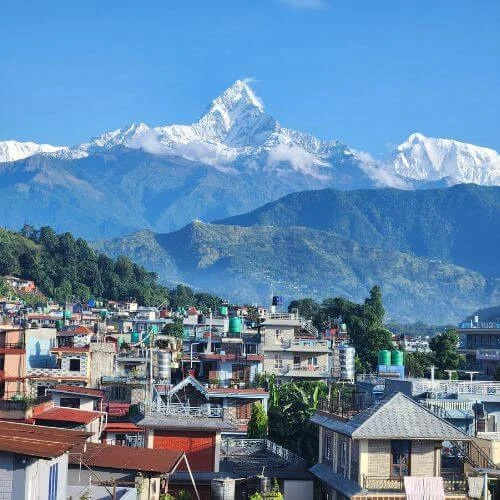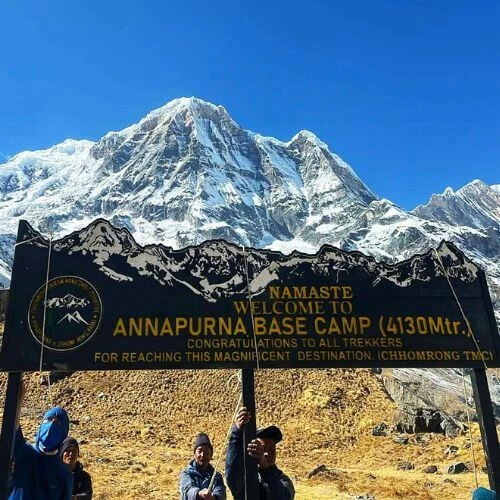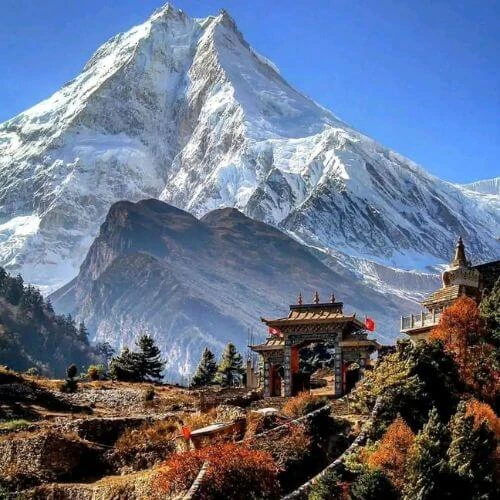Best time to visit Everest Base Camp
January
January is generally considered the as coldest month, though trekking in the Everest base camp is possible it comes with challenges. Being considered as the off-season for trekking, winter in the Everest region during this month is unimaginably freezing. Day-time temperatures lingers around 8-12 degrees Celsius and night-time temperatures drops to minus 20 degrees Celsius or even lower. Heavy snowfall often leads to closed routes, particularly those involving crossing three passes.
Winter weather can make flights get delayed or cancelled more often. However, the winter air is clear, and you get to see amazing views of snowy landscapes during the trek. It's less crowded in January, so you'll have a queiter trek. Finding a place to stay is easy. They expect you to have your meals at their place and some tea houses even give free rooms if you eat there.
Trekking in the Everest base camp in January requires high preparation. It is essential to bring suitable gears, including insulated clothing, down jackets, warm gloves, hats, and sturdy boots with good traction.

February
In February, the Everest region marks the conclusion of winter. Daytime temperatures at lower altitudes can reach around 8°C (46.4°F), while higher altitudes, including Everest Base Camp, may still experience freezing daytime temperatures and night-time lows dropping to -15°C (5°F) or even lower.
Compared to January, there is a slight decrease in snowfall in February, improving trail conditions. Although the weather remains cold, the trails are less crowded, providing a more serene trekking experience. The clear winter skies offer exceptional views of Everest, with a reduced likelihood of snow blocking the stunning Himalayan views. However, occasional strong winds should be noted.
This trek is inherently challenging, even under favourable conditions. The colder temperatures and potential trail challenges make it suitable mainly for experienced trekkers with proper gear and knowledge. Ice and snow on the trails can add to the difficulty, requiring using microspikes or crampons for safe passage.
However, in February, some places along the trek might have limited services because it's considered the off-season. Certain tea houses or lodges at higher elevations could be closed, making it harder to find accommodation and food.
March
March is a great time to visit the Everest region because it marks the beginning of spring. During this season, you can expect warmer weather with very little chance of rain or snow in the mountains. It's a popular time for trekkers and expedition groups, so it's important to book your hotels in advance.
In March, daytime temperatures reach around 7°C, making it feel quite warm as you ascend the mountain. However, nights can get chilly, with average minimum temperatures dropping to around -12°C. So, it is always a good idea to bring some extra layers for the cold nights.
As spring begins, you'll witness the lasting effects of winter and the emergence of new life. Various flowers like rhododendrons, dwarf rhododendrons, barberries, junipers, birches, and wild roses start to bloom. The lower areas have a greater variety of plants compared to the higher elevations near Everest Base Camp.
The views on the trails to Everest Base Camp in March are spectacular. The sky is clear so that you can see the stunning mountain ranges without anything blocking your view. It's a beautiful time to experience nature's beauty and witness the signs of spring.

April
April is the popular and ideal month to begin the Everest Base Camp trek in the spring season among the spring months. In April, the weather is warmer than in March, but it's still dry.
The EBC trail gets busy in April as many expeditions start during this month. Finding a place to stay on the standard route can be tough because accommodations fill up quickly. It's crucial to have a good guide who can secure a comfortable bed for you in a teahouse. If you prefer a quieter experience, you can choose an alternative route, which is usually less crowded than the main path.
April is an excellent time for climbing peaks and tackling high passes, and the days are longer, giving you more time to explore. The weather in April is just right – not too hot or cold. In April, daytime temperatures reach around 10 °C, and at night, it can drop to about -12 °C. While there might be occasional rainfall, it's wise to carry proper gear, including a raincoat.
You'll enjoy pleasant weather with clear blue skies and comfortable temperatures in April. It's the perfect time to see the rhododendron, Nepal's national flower. Sagarmatha National Park, filled with birch, fir, and juniper trees, becomes even more vibrant with blooming flowers compared to March.
May
May is a favourable time for trekking to Everest Base Camp as it's only a few weeks away from the beginning of the monsoon season, which typically begins later in the month. The early part of May is warmer and clearer, falling in the spring season, but the trail is much more crowded during this period. Despite occasional thunderstorms, trekking temperatures remain comfortable. Daytime temperatures range from 15 to 22 degrees Celsius, while nights can get chilly, dropping to around 0 degrees Celsius in the Everest Region. The Base Camp area stays cold day and night, but you can expect bright sunshine and warm weather.
Early May provides clearer skies with a lower chance of rain or snow, offering breathtaking views of the Himalayas, including Mount Everest. The days are longer, giving more time for trekking and enjoying the scenery. Teahouses and lodges along the route are open, ensuring easy access to food and accommodation.
Due to the popularity of this trek in May, it's important to plan by booking flights, permits, and accommodations well in advance, especially if you're travelling during peak season.

June
June marks the start of the monsoon season in the Everest region, and fewer people trek compared to May. The rain transforms the usually dry landscape into a lush scene with blooming wildflowers. July is considered an off-season for trekking in Everest and other regions as rainfall is common during this time of the year.
The main downside of trekking in June is slippery, making trekking more difficult. Bad weather, especially during monsoon rains, may lead to flight cancellations to Lukla, the entry point to the Everest region.
In June, the daytime temperatures reach around 16°C, and at night, it can drop to about -1°C. However, temperatures can change quite a bit during rainfall. Since the rainfall is less than in July, trekking in June is possible. Therefore, it's recommended to wear layered and waterproof clothing to stay warm and dry in case of rain.
July
In July, the Everest region experiences the peak of the monsoon season with frequent and heavy rainfall. The weather gets hotter compared to June and remains hot and humid. This is the main month for monsoon, so there's generally a lot of rain, though higher-altitude areas receive less. If you're prepared for rainy weather and understand that the rain may obstruct your views, it is still possible to trek to Everest Base Camp in monsoon season, although it comes with its challenges.
Throughout July, daytime temperatures usually reach around 15°C; at night, it gets to about 2°C. However, trekking is not recommended during this month. Aside from getting wet, the trails become sloppier, and there's a risk of landslides. Clouds and rain can also make it difficult to see the majestic Himalayan views you might be hoping for.

August
In August, the monsoon season in the Everest region comes to an end. The lower altitudes become lush and green, and the Himalayas are clear and free from monsoon clouds. August marks the beginning of the trekking season in Nepal, as June and July are considered off-season due to the monsoon. Travellers are welcomed into the Himalayas with breathtaking views and serene trails. Since it's the start of the trekking season, there are fewer people around, providing a quiet and peaceful experience with nature. While there might be some rain at lower altitudes, areas above 3500 metres in the Himalayas generally stay dry.
Throughout August, daytime temperatures usually reach highs of around 16°C; at night, temperatures drop to around 2°C, creating nice and warm weather.
September
September marks the beginning of the autumn season in Nepal, and it's the start of the peak season for the Everest trek in the autumn season. Light rainfall may still occur until early September. During this time, temperatures at Everest Base Camp range from 8 to 15 degrees Celsius during the day and 7 to -1 degrees Celsius at night. It's advisable to bring warm clothes for cooler nights and rainproof gear for occasional rainfall. With the monsoon receding, September provides a better chance to enjoy breathtaking views of the Himalayas, including Mount Everest, without being blocked by clouds.
Compared to the peak season in April-May, September experiences fewer trekkers, offering a more peaceful experience on the trails. The monsoon rains also help nurture wildflowers, adding vibrant colours to the landscape. While there might still be occasional rainfall in early September, packing rain gear is recommended. The Everest Base Camp trail isn't as crowded in September as it marks the beginning of the autumn season; post monsoon making it easier to find rooms at tea houses and hotels.

October
October is considered the best time for trekking in the Everest region due to the great weather, breathtaking scenery, and lively atmosphere. This allows for stunning, unblocked views of the Himalayas, including Mount Everest, Lhotse, Nuptse, and others. The temperatures in October are pleasant for trekking, around 12 degrees Celsius during the day and 5 degrees Celsius at night in the Everest Base Camp area. While nights can be cool, they are generally not freezing. The post-monsoon period leaves the landscape fresh and lush, with vibrant vegetation in some areas. Dry trails make trekking more enjoyable and safer than during the slippery monsoon season. Comfortable temperatures make trekking and enjoying the scenery more pleasant without extreme heat or cold.
Towards the end of October, temperatures may drop slightly, so consider packing layers for potentially cooler nights. Although most tea houses are open in October, it's advisable to book accommodation in advance, especially during peak season.

November
November is considered the best month for trekking in the Everest region of Nepal, marking the tail end of the trekking season. The weather is stable, cooler than October, and there's a low chance of rainfall. The skies are clear and blue, offering magnificent 360-degree panoramic views of snow-capped mountains from viewpoints like Kalapathar and Everest Base Camp. The monsoon season has cleared out, resulting in minimal chances of rain. Temperatures are mild and comfortable for trekking, with average highs in Namche Bazaar ranging from 5°C to 10°C (41°F to 50°F). Nights can be chilly, especially at higher altitudes, so proper layering and a good sleeping bag are essential for warmth. Towards the end of November, temperatures may drop significantly. It is also a great time for trekking with fewer chances of flight cancellations or delays due to the stable weather.
December
In the Everest region, December marks the beginning of winter, bringing extreme cold and tough weather. It's one of the coldest times there, with nights dropping to -14 degrees Celsius and days ranging from 15 to 20 degrees Celsius. Snow and ice on the trails make trekking harder, especially at higher elevations where there's frequent snowfall, making paths slippery. You'll need special gear like microspikes or crampons for safety. December has less snow compared to later months, but it's still important to navigate safely. Since it's the off-season, you'll encounter fewer trekkers. If the weather's clear, you might get stunning views of the Himalayas. Despite the challenges, Everest base camp trekking in winter is still doable with a trained and licensed guide from a reputable company.

Peak season and crowd
The Everest Base Camp is great for trekking all year round. Travellers often wonder when is the best time to trek to EBC for the best views of the mountains and landscapes. For those seeking adventure and breathtaking scenery, the best time to visit is during the spring and autumn seasons i.e. peak seasons. Even though there might be more people during these times, the Mt. Everest base camp weather is fantastic, providing excellent conditions for trekking and amazing views of Mount Everest and the surrounding landscapes.
Nepal's weather is top-notch in spring (March to May) and fall (October to November). The skies are clear, and it's not too hot or cold. But, keep in mind, these are the busiest months, so expect lots of trekkers on the trails.
With more people around, spots like Namche Bazaar and Gorakshep can get crowded, leading to more crowds at the teahouse. It's a good idea to book your accommodation in advance to ensure you get a spot, especially during peak times.
Also, the airport can get pretty busy during these peak seasons. There are no flights from Kathmandu to Lukla from April 1st to May 30th and October 1st to November 30th each year. Instead, you'll need to use Manthali Airport in Ramechhap. The drive there takes about 5 hours, and the return to Kathmandu can be 5 to 8 hours, depending on traffic. This change aims to ease congestion at the airport. So, get everything ready beforehand and enjoy your trekking adventure in Nepal.

Conclusion
Everest Base Camp should be on your travel list for an amazing trekking experience. The best times to go to Everest Base Camp are in spring (late April to early June) or autumn (late September to early November) when the weather is stable and the skies are clear. Winter is tougher with freezing temperatures and snow, while the monsoon season from June to early September brings rain and muddy trails. Planning carefully and considering your preferences is key for a safe trek. Be ready for changing conditions and choose the time that suits your liking for crowds, weather, and the trekking experience. At the Base Camp, you'll see stunning views of the Himalayan peaks, including Mt. Everest, Lhotse, Choyu, and Nuptse, surrounded by snow-capped mountains, deep valleys, and breathtaking glaciers and good weather is crucial for enjoying these majestic sights.



 based on 15 reviews
based on 15 reviews










